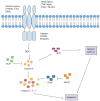Apoptosis: A Target for Anticancer Therapy
- PMID: 29393886
- PMCID: PMC5855670
- DOI: 10.3390/ijms19020448
Apoptosis: A Target for Anticancer Therapy
Abstract
Apoptosis, the cell's natural mechanism for death, is a promising target for anticancer therapy. Both the intrinsic and extrinsic pathways use caspases to carry out apoptosis through the cleavage of hundreds of proteins. In cancer, the apoptotic pathway is typically inhibited through a wide variety of means including overexpression of antiapoptotic proteins and under-expression of proapoptotic proteins. Many of these changes cause intrinsic resistance to the most common anticancer therapy, chemotherapy. Promising new anticancer therapies are plant-derived compounds that exhibit anticancer activity through activating the apoptotic pathway.
Keywords: anticancer therapy; apoptosis; apoptotic evasion; curcumin.
Conflict of interest statement
The authors declare no conflict of interest.
Figures


References
Publication types
MeSH terms
Substances
LinkOut - more resources
Full Text Sources
Other Literature Sources
Research Materials

